Health Systems and Change: Implementing Patient Surveys AUT2018
VerifiedAdded on 2023/06/11
|8
|2166
|385
Essay
AI Summary
This essay discusses the importance of implementing patient experience surveys within a healthcare setting to improve service delivery and patient satisfaction. It highlights the shift from a fee-for-service model to one that values patient feedback and outcomes. The essay identifies potential barriers to implementing these surveys, such as lack of employee involvement, poor communication, clinical complexity, unfamiliarity with the new state, and a negative culture towards change. To overcome these obstacles, the paper advocates for a participative leadership style that involves all stakeholders in the change process, fostering a sense of recognition and motivation. Ultimately, the goal is to bridge the communication gap between healthcare providers and patients, leading to enhanced healthcare services. Desklib provides access to similar assignments and resources for students.
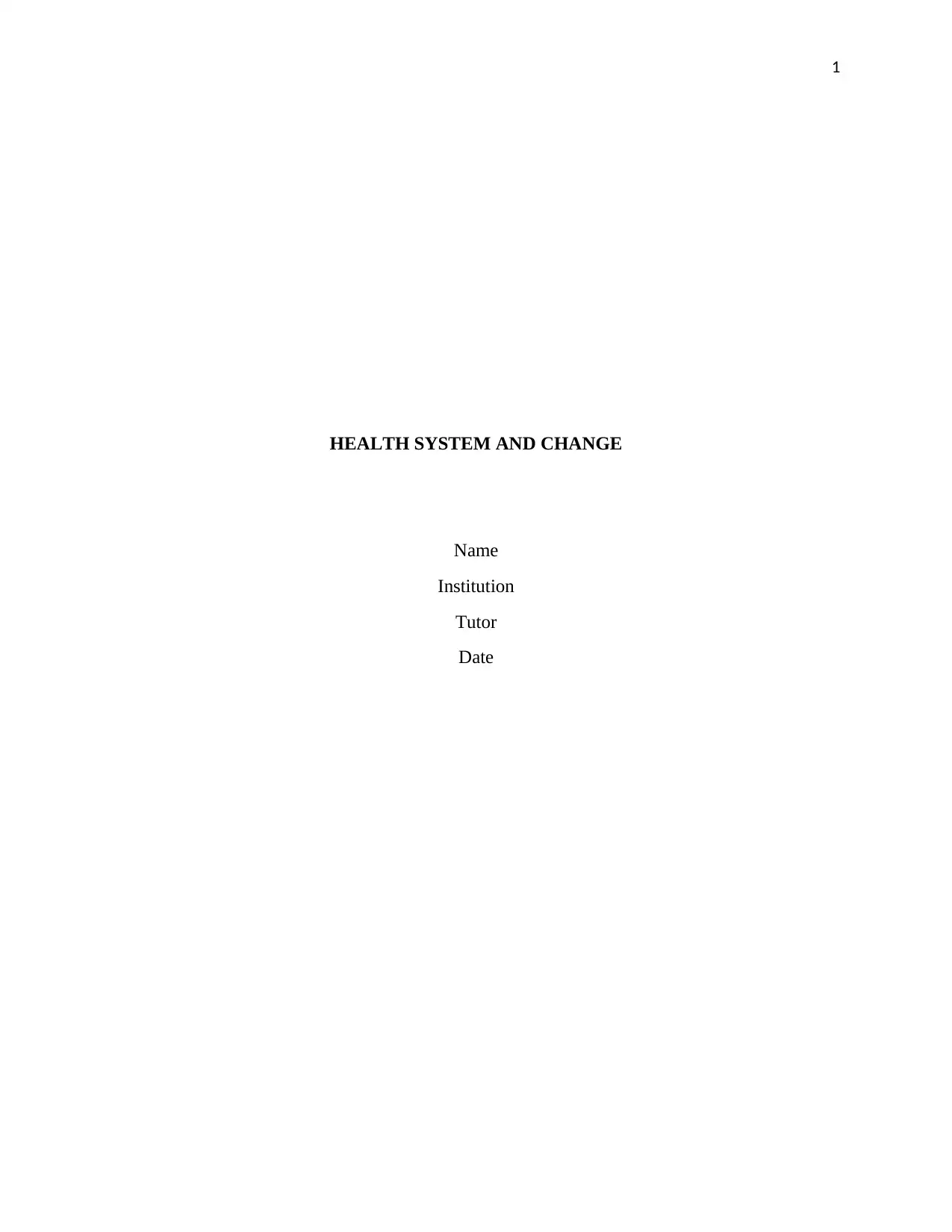
1
HEALTH SYSTEM AND CHANGE
Name
Institution
Tutor
Date
HEALTH SYSTEM AND CHANGE
Name
Institution
Tutor
Date
Paraphrase This Document
Need a fresh take? Get an instant paraphrase of this document with our AI Paraphraser
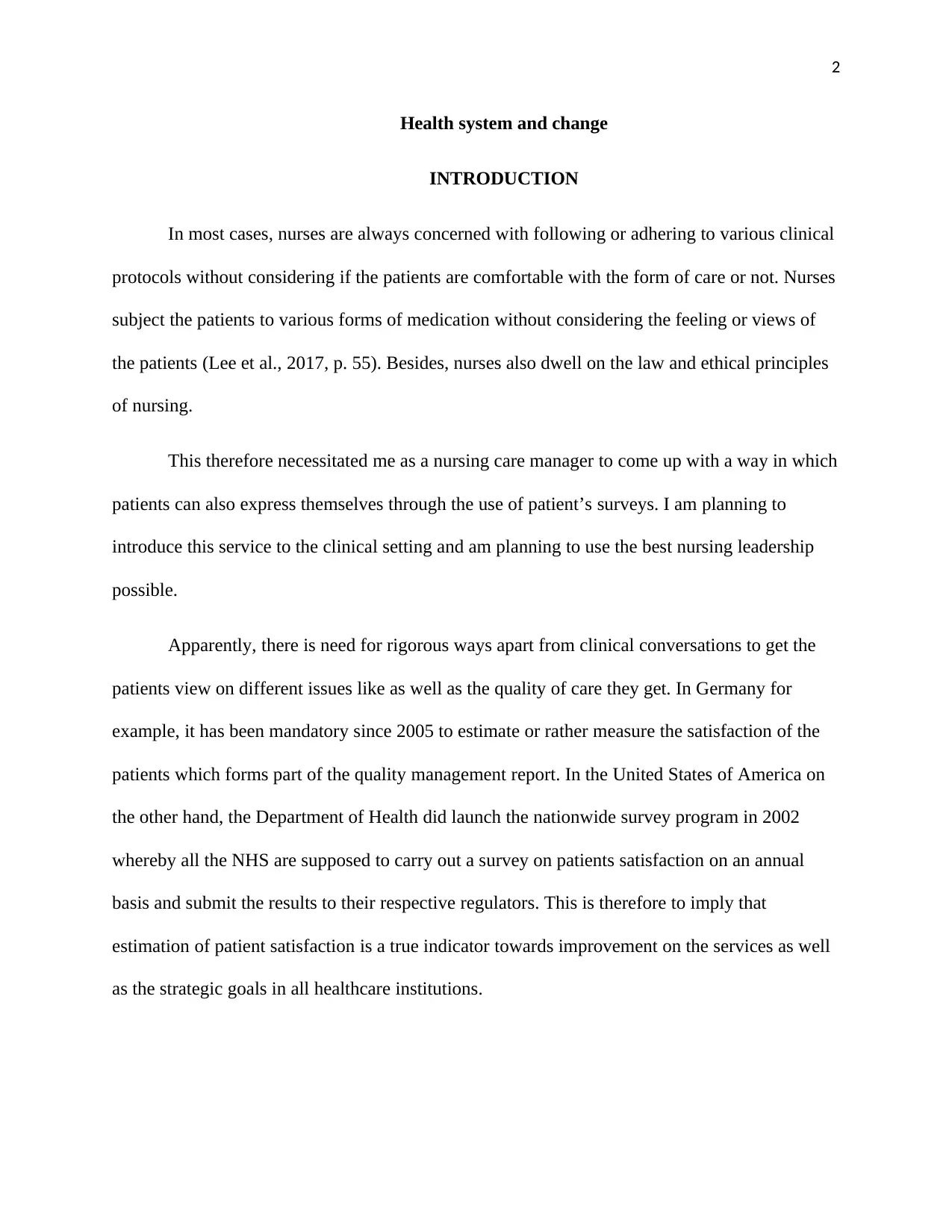
2
Health system and change
INTRODUCTION
In most cases, nurses are always concerned with following or adhering to various clinical
protocols without considering if the patients are comfortable with the form of care or not. Nurses
subject the patients to various forms of medication without considering the feeling or views of
the patients (Lee et al., 2017, p. 55). Besides, nurses also dwell on the law and ethical principles
of nursing.
This therefore necessitated me as a nursing care manager to come up with a way in which
patients can also express themselves through the use of patient’s surveys. I am planning to
introduce this service to the clinical setting and am planning to use the best nursing leadership
possible.
Apparently, there is need for rigorous ways apart from clinical conversations to get the
patients view on different issues like as well as the quality of care they get. In Germany for
example, it has been mandatory since 2005 to estimate or rather measure the satisfaction of the
patients which forms part of the quality management report. In the United States of America on
the other hand, the Department of Health did launch the nationwide survey program in 2002
whereby all the NHS are supposed to carry out a survey on patients satisfaction on an annual
basis and submit the results to their respective regulators. This is therefore to imply that
estimation of patient satisfaction is a true indicator towards improvement on the services as well
as the strategic goals in all healthcare institutions.
Health system and change
INTRODUCTION
In most cases, nurses are always concerned with following or adhering to various clinical
protocols without considering if the patients are comfortable with the form of care or not. Nurses
subject the patients to various forms of medication without considering the feeling or views of
the patients (Lee et al., 2017, p. 55). Besides, nurses also dwell on the law and ethical principles
of nursing.
This therefore necessitated me as a nursing care manager to come up with a way in which
patients can also express themselves through the use of patient’s surveys. I am planning to
introduce this service to the clinical setting and am planning to use the best nursing leadership
possible.
Apparently, there is need for rigorous ways apart from clinical conversations to get the
patients view on different issues like as well as the quality of care they get. In Germany for
example, it has been mandatory since 2005 to estimate or rather measure the satisfaction of the
patients which forms part of the quality management report. In the United States of America on
the other hand, the Department of Health did launch the nationwide survey program in 2002
whereby all the NHS are supposed to carry out a survey on patients satisfaction on an annual
basis and submit the results to their respective regulators. This is therefore to imply that
estimation of patient satisfaction is a true indicator towards improvement on the services as well
as the strategic goals in all healthcare institutions.
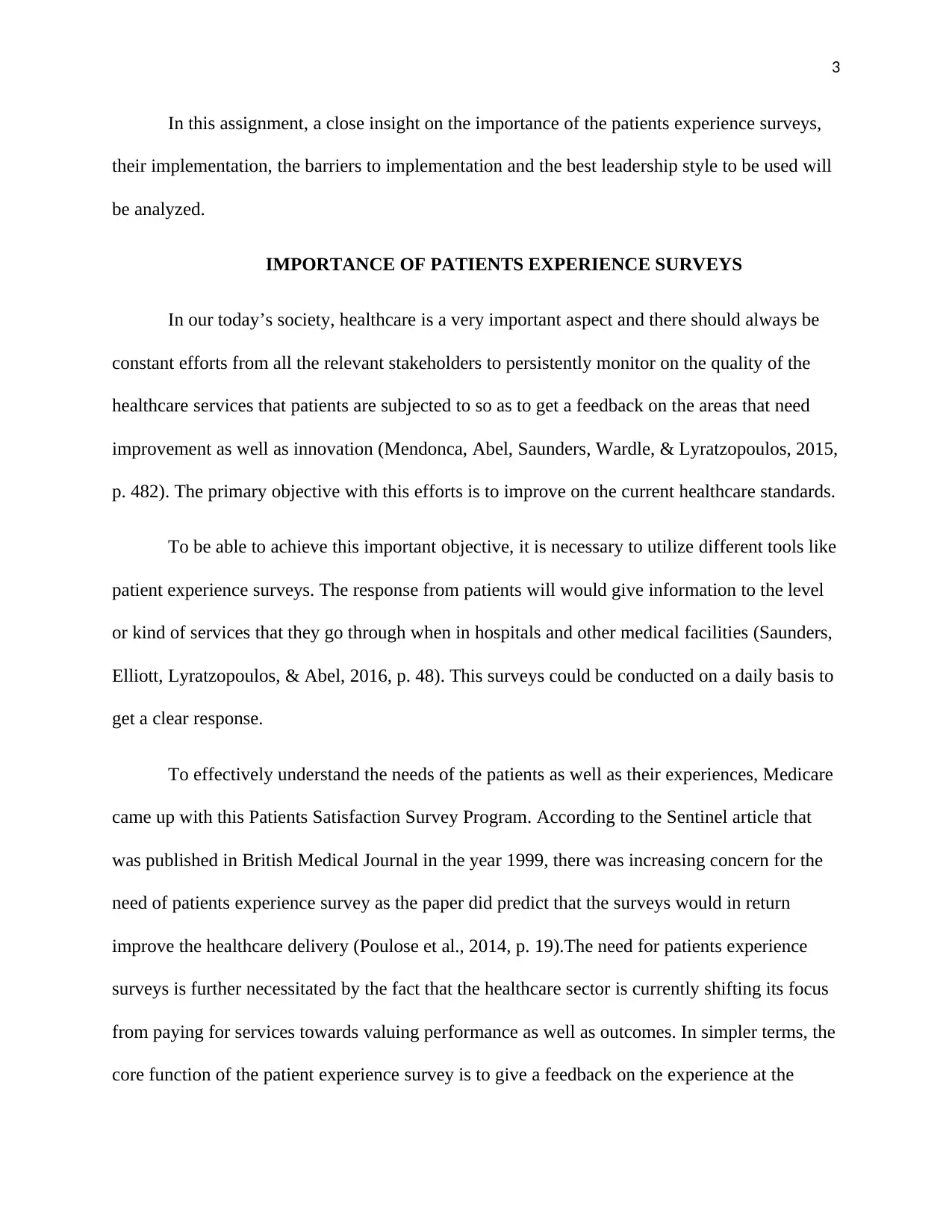
3
In this assignment, a close insight on the importance of the patients experience surveys,
their implementation, the barriers to implementation and the best leadership style to be used will
be analyzed.
IMPORTANCE OF PATIENTS EXPERIENCE SURVEYS
In our today’s society, healthcare is a very important aspect and there should always be
constant efforts from all the relevant stakeholders to persistently monitor on the quality of the
healthcare services that patients are subjected to so as to get a feedback on the areas that need
improvement as well as innovation (Mendonca, Abel, Saunders, Wardle, & Lyratzopoulos, 2015,
p. 482). The primary objective with this efforts is to improve on the current healthcare standards.
To be able to achieve this important objective, it is necessary to utilize different tools like
patient experience surveys. The response from patients will would give information to the level
or kind of services that they go through when in hospitals and other medical facilities (Saunders,
Elliott, Lyratzopoulos, & Abel, 2016, p. 48). This surveys could be conducted on a daily basis to
get a clear response.
To effectively understand the needs of the patients as well as their experiences, Medicare
came up with this Patients Satisfaction Survey Program. According to the Sentinel article that
was published in British Medical Journal in the year 1999, there was increasing concern for the
need of patients experience survey as the paper did predict that the surveys would in return
improve the healthcare delivery (Poulose et al., 2014, p. 19).The need for patients experience
surveys is further necessitated by the fact that the healthcare sector is currently shifting its focus
from paying for services towards valuing performance as well as outcomes. In simpler terms, the
core function of the patient experience survey is to give a feedback on the experience at the
In this assignment, a close insight on the importance of the patients experience surveys,
their implementation, the barriers to implementation and the best leadership style to be used will
be analyzed.
IMPORTANCE OF PATIENTS EXPERIENCE SURVEYS
In our today’s society, healthcare is a very important aspect and there should always be
constant efforts from all the relevant stakeholders to persistently monitor on the quality of the
healthcare services that patients are subjected to so as to get a feedback on the areas that need
improvement as well as innovation (Mendonca, Abel, Saunders, Wardle, & Lyratzopoulos, 2015,
p. 482). The primary objective with this efforts is to improve on the current healthcare standards.
To be able to achieve this important objective, it is necessary to utilize different tools like
patient experience surveys. The response from patients will would give information to the level
or kind of services that they go through when in hospitals and other medical facilities (Saunders,
Elliott, Lyratzopoulos, & Abel, 2016, p. 48). This surveys could be conducted on a daily basis to
get a clear response.
To effectively understand the needs of the patients as well as their experiences, Medicare
came up with this Patients Satisfaction Survey Program. According to the Sentinel article that
was published in British Medical Journal in the year 1999, there was increasing concern for the
need of patients experience survey as the paper did predict that the surveys would in return
improve the healthcare delivery (Poulose et al., 2014, p. 19).The need for patients experience
surveys is further necessitated by the fact that the healthcare sector is currently shifting its focus
from paying for services towards valuing performance as well as outcomes. In simpler terms, the
core function of the patient experience survey is to give a feedback on the experience at the
⊘ This is a preview!⊘
Do you want full access?
Subscribe today to unlock all pages.

Trusted by 1+ million students worldwide
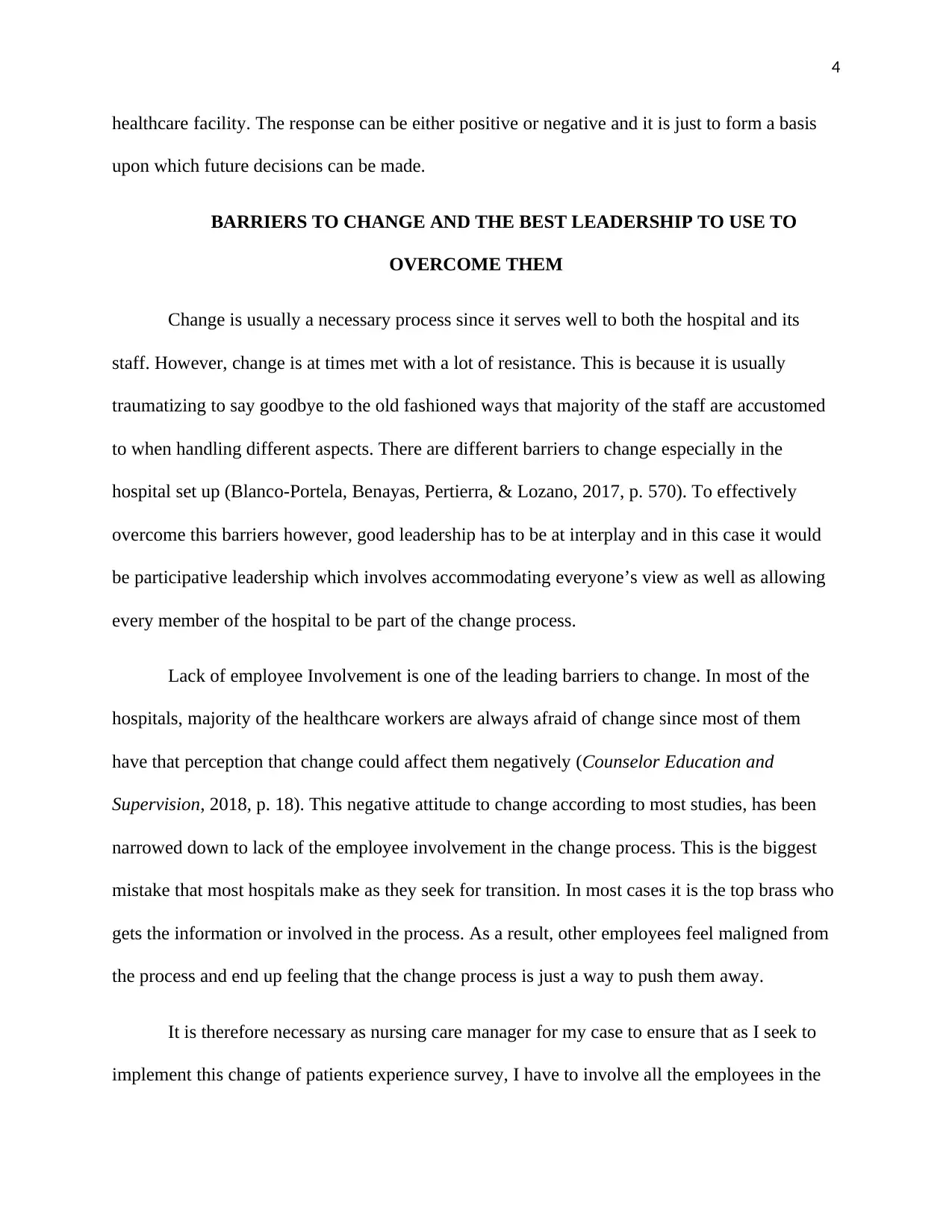
4
healthcare facility. The response can be either positive or negative and it is just to form a basis
upon which future decisions can be made.
BARRIERS TO CHANGE AND THE BEST LEADERSHIP TO USE TO
OVERCOME THEM
Change is usually a necessary process since it serves well to both the hospital and its
staff. However, change is at times met with a lot of resistance. This is because it is usually
traumatizing to say goodbye to the old fashioned ways that majority of the staff are accustomed
to when handling different aspects. There are different barriers to change especially in the
hospital set up (Blanco-Portela, Benayas, Pertierra, & Lozano, 2017, p. 570). To effectively
overcome this barriers however, good leadership has to be at interplay and in this case it would
be participative leadership which involves accommodating everyone’s view as well as allowing
every member of the hospital to be part of the change process.
Lack of employee Involvement is one of the leading barriers to change. In most of the
hospitals, majority of the healthcare workers are always afraid of change since most of them
have that perception that change could affect them negatively (Counselor Education and
Supervision, 2018, p. 18). This negative attitude to change according to most studies, has been
narrowed down to lack of the employee involvement in the change process. This is the biggest
mistake that most hospitals make as they seek for transition. In most cases it is the top brass who
gets the information or involved in the process. As a result, other employees feel maligned from
the process and end up feeling that the change process is just a way to push them away.
It is therefore necessary as nursing care manager for my case to ensure that as I seek to
implement this change of patients experience survey, I have to involve all the employees in the
healthcare facility. The response can be either positive or negative and it is just to form a basis
upon which future decisions can be made.
BARRIERS TO CHANGE AND THE BEST LEADERSHIP TO USE TO
OVERCOME THEM
Change is usually a necessary process since it serves well to both the hospital and its
staff. However, change is at times met with a lot of resistance. This is because it is usually
traumatizing to say goodbye to the old fashioned ways that majority of the staff are accustomed
to when handling different aspects. There are different barriers to change especially in the
hospital set up (Blanco-Portela, Benayas, Pertierra, & Lozano, 2017, p. 570). To effectively
overcome this barriers however, good leadership has to be at interplay and in this case it would
be participative leadership which involves accommodating everyone’s view as well as allowing
every member of the hospital to be part of the change process.
Lack of employee Involvement is one of the leading barriers to change. In most of the
hospitals, majority of the healthcare workers are always afraid of change since most of them
have that perception that change could affect them negatively (Counselor Education and
Supervision, 2018, p. 18). This negative attitude to change according to most studies, has been
narrowed down to lack of the employee involvement in the change process. This is the biggest
mistake that most hospitals make as they seek for transition. In most cases it is the top brass who
gets the information or involved in the process. As a result, other employees feel maligned from
the process and end up feeling that the change process is just a way to push them away.
It is therefore necessary as nursing care manager for my case to ensure that as I seek to
implement this change of patients experience survey, I have to involve all the employees in the
Paraphrase This Document
Need a fresh take? Get an instant paraphrase of this document with our AI Paraphraser
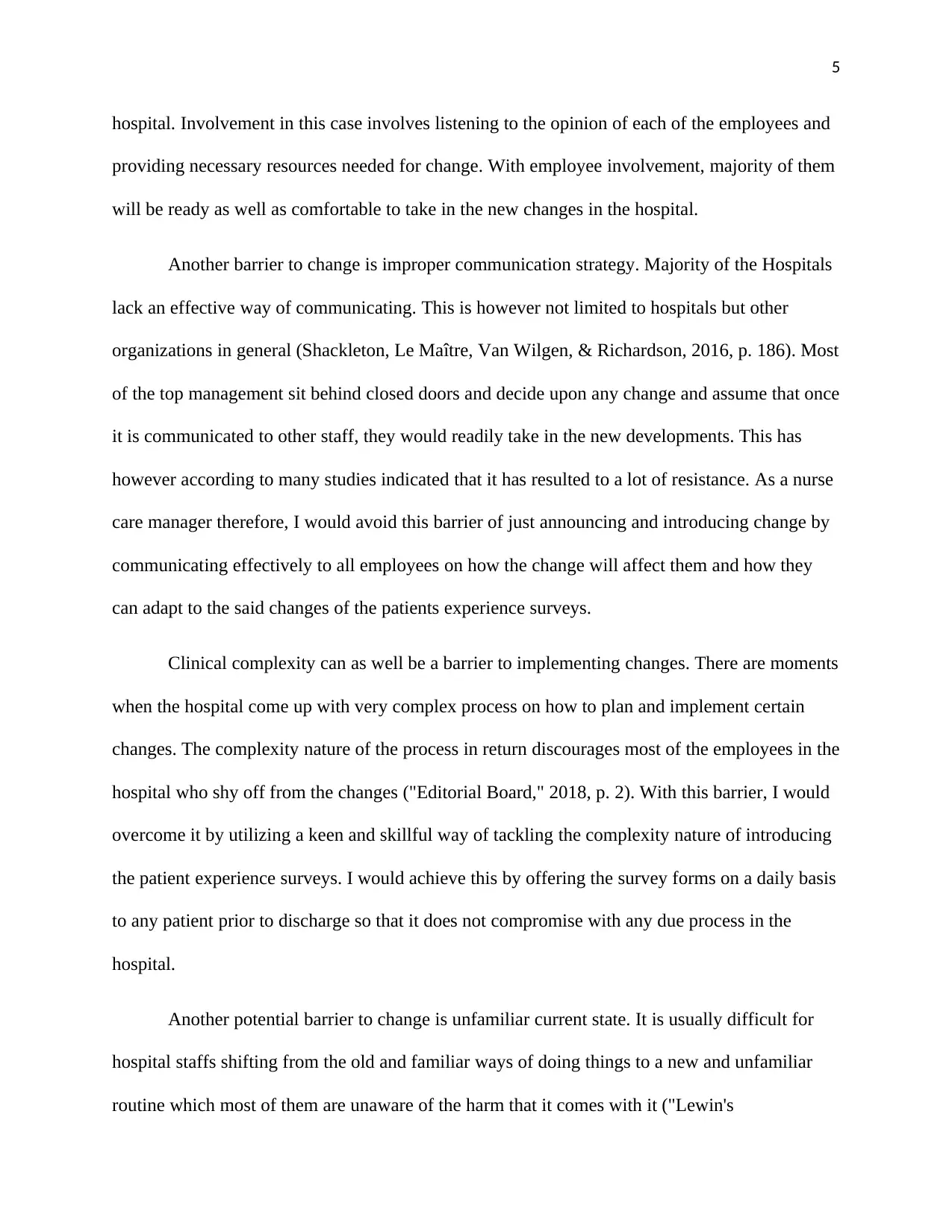
5
hospital. Involvement in this case involves listening to the opinion of each of the employees and
providing necessary resources needed for change. With employee involvement, majority of them
will be ready as well as comfortable to take in the new changes in the hospital.
Another barrier to change is improper communication strategy. Majority of the Hospitals
lack an effective way of communicating. This is however not limited to hospitals but other
organizations in general (Shackleton, Le Maître, Van Wilgen, & Richardson, 2016, p. 186). Most
of the top management sit behind closed doors and decide upon any change and assume that once
it is communicated to other staff, they would readily take in the new developments. This has
however according to many studies indicated that it has resulted to a lot of resistance. As a nurse
care manager therefore, I would avoid this barrier of just announcing and introducing change by
communicating effectively to all employees on how the change will affect them and how they
can adapt to the said changes of the patients experience surveys.
Clinical complexity can as well be a barrier to implementing changes. There are moments
when the hospital come up with very complex process on how to plan and implement certain
changes. The complexity nature of the process in return discourages most of the employees in the
hospital who shy off from the changes ("Editorial Board," 2018, p. 2). With this barrier, I would
overcome it by utilizing a keen and skillful way of tackling the complexity nature of introducing
the patient experience surveys. I would achieve this by offering the survey forms on a daily basis
to any patient prior to discharge so that it does not compromise with any due process in the
hospital.
Another potential barrier to change is unfamiliar current state. It is usually difficult for
hospital staffs shifting from the old and familiar ways of doing things to a new and unfamiliar
routine which most of them are unaware of the harm that it comes with it ("Lewin's
hospital. Involvement in this case involves listening to the opinion of each of the employees and
providing necessary resources needed for change. With employee involvement, majority of them
will be ready as well as comfortable to take in the new changes in the hospital.
Another barrier to change is improper communication strategy. Majority of the Hospitals
lack an effective way of communicating. This is however not limited to hospitals but other
organizations in general (Shackleton, Le Maître, Van Wilgen, & Richardson, 2016, p. 186). Most
of the top management sit behind closed doors and decide upon any change and assume that once
it is communicated to other staff, they would readily take in the new developments. This has
however according to many studies indicated that it has resulted to a lot of resistance. As a nurse
care manager therefore, I would avoid this barrier of just announcing and introducing change by
communicating effectively to all employees on how the change will affect them and how they
can adapt to the said changes of the patients experience surveys.
Clinical complexity can as well be a barrier to implementing changes. There are moments
when the hospital come up with very complex process on how to plan and implement certain
changes. The complexity nature of the process in return discourages most of the employees in the
hospital who shy off from the changes ("Editorial Board," 2018, p. 2). With this barrier, I would
overcome it by utilizing a keen and skillful way of tackling the complexity nature of introducing
the patient experience surveys. I would achieve this by offering the survey forms on a daily basis
to any patient prior to discharge so that it does not compromise with any due process in the
hospital.
Another potential barrier to change is unfamiliar current state. It is usually difficult for
hospital staffs shifting from the old and familiar ways of doing things to a new and unfamiliar
routine which most of them are unaware of the harm that it comes with it ("Lewin's
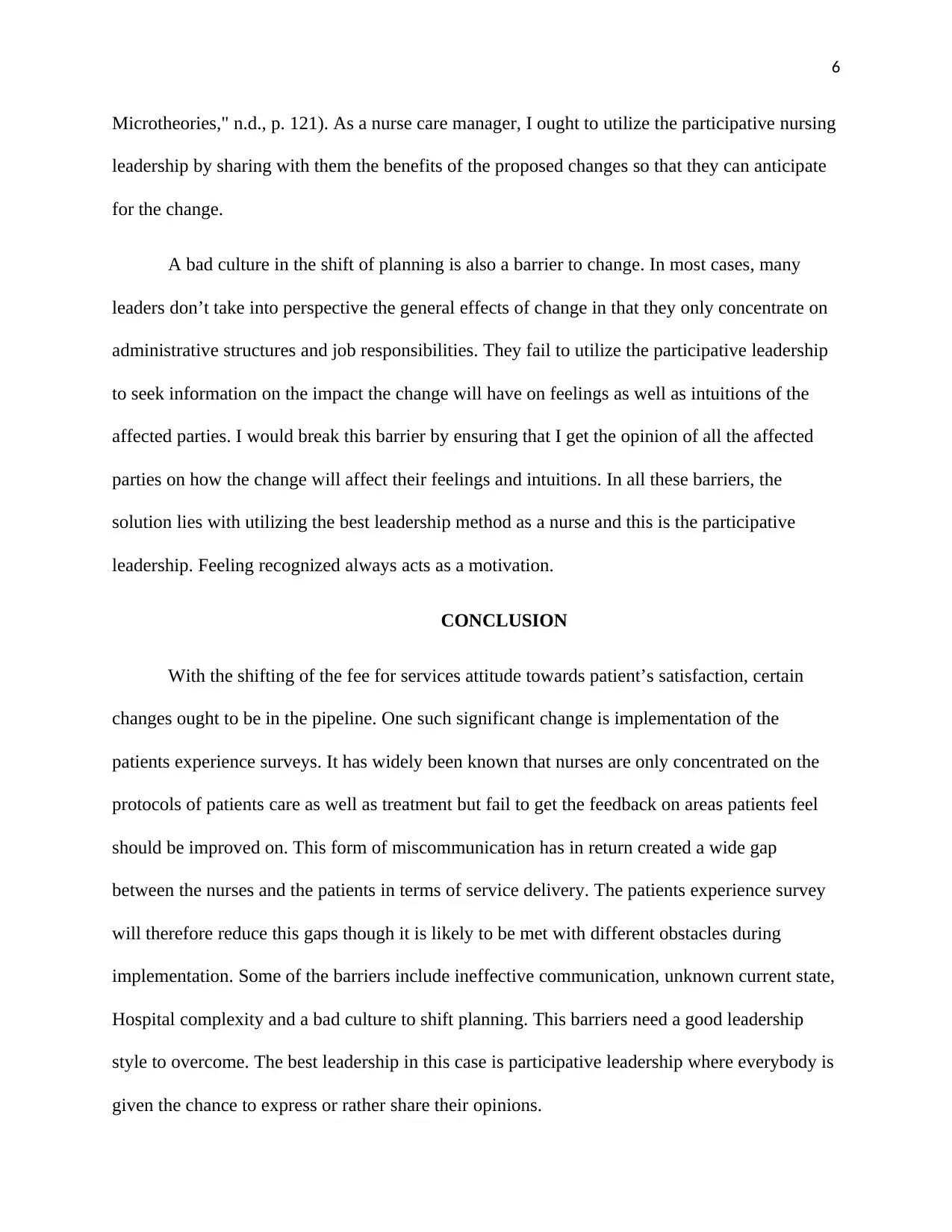
6
Microtheories," n.d., p. 121). As a nurse care manager, I ought to utilize the participative nursing
leadership by sharing with them the benefits of the proposed changes so that they can anticipate
for the change.
A bad culture in the shift of planning is also a barrier to change. In most cases, many
leaders don’t take into perspective the general effects of change in that they only concentrate on
administrative structures and job responsibilities. They fail to utilize the participative leadership
to seek information on the impact the change will have on feelings as well as intuitions of the
affected parties. I would break this barrier by ensuring that I get the opinion of all the affected
parties on how the change will affect their feelings and intuitions. In all these barriers, the
solution lies with utilizing the best leadership method as a nurse and this is the participative
leadership. Feeling recognized always acts as a motivation.
CONCLUSION
With the shifting of the fee for services attitude towards patient’s satisfaction, certain
changes ought to be in the pipeline. One such significant change is implementation of the
patients experience surveys. It has widely been known that nurses are only concentrated on the
protocols of patients care as well as treatment but fail to get the feedback on areas patients feel
should be improved on. This form of miscommunication has in return created a wide gap
between the nurses and the patients in terms of service delivery. The patients experience survey
will therefore reduce this gaps though it is likely to be met with different obstacles during
implementation. Some of the barriers include ineffective communication, unknown current state,
Hospital complexity and a bad culture to shift planning. This barriers need a good leadership
style to overcome. The best leadership in this case is participative leadership where everybody is
given the chance to express or rather share their opinions.
Microtheories," n.d., p. 121). As a nurse care manager, I ought to utilize the participative nursing
leadership by sharing with them the benefits of the proposed changes so that they can anticipate
for the change.
A bad culture in the shift of planning is also a barrier to change. In most cases, many
leaders don’t take into perspective the general effects of change in that they only concentrate on
administrative structures and job responsibilities. They fail to utilize the participative leadership
to seek information on the impact the change will have on feelings as well as intuitions of the
affected parties. I would break this barrier by ensuring that I get the opinion of all the affected
parties on how the change will affect their feelings and intuitions. In all these barriers, the
solution lies with utilizing the best leadership method as a nurse and this is the participative
leadership. Feeling recognized always acts as a motivation.
CONCLUSION
With the shifting of the fee for services attitude towards patient’s satisfaction, certain
changes ought to be in the pipeline. One such significant change is implementation of the
patients experience surveys. It has widely been known that nurses are only concentrated on the
protocols of patients care as well as treatment but fail to get the feedback on areas patients feel
should be improved on. This form of miscommunication has in return created a wide gap
between the nurses and the patients in terms of service delivery. The patients experience survey
will therefore reduce this gaps though it is likely to be met with different obstacles during
implementation. Some of the barriers include ineffective communication, unknown current state,
Hospital complexity and a bad culture to shift planning. This barriers need a good leadership
style to overcome. The best leadership in this case is participative leadership where everybody is
given the chance to express or rather share their opinions.
⊘ This is a preview!⊘
Do you want full access?
Subscribe today to unlock all pages.

Trusted by 1+ million students worldwide
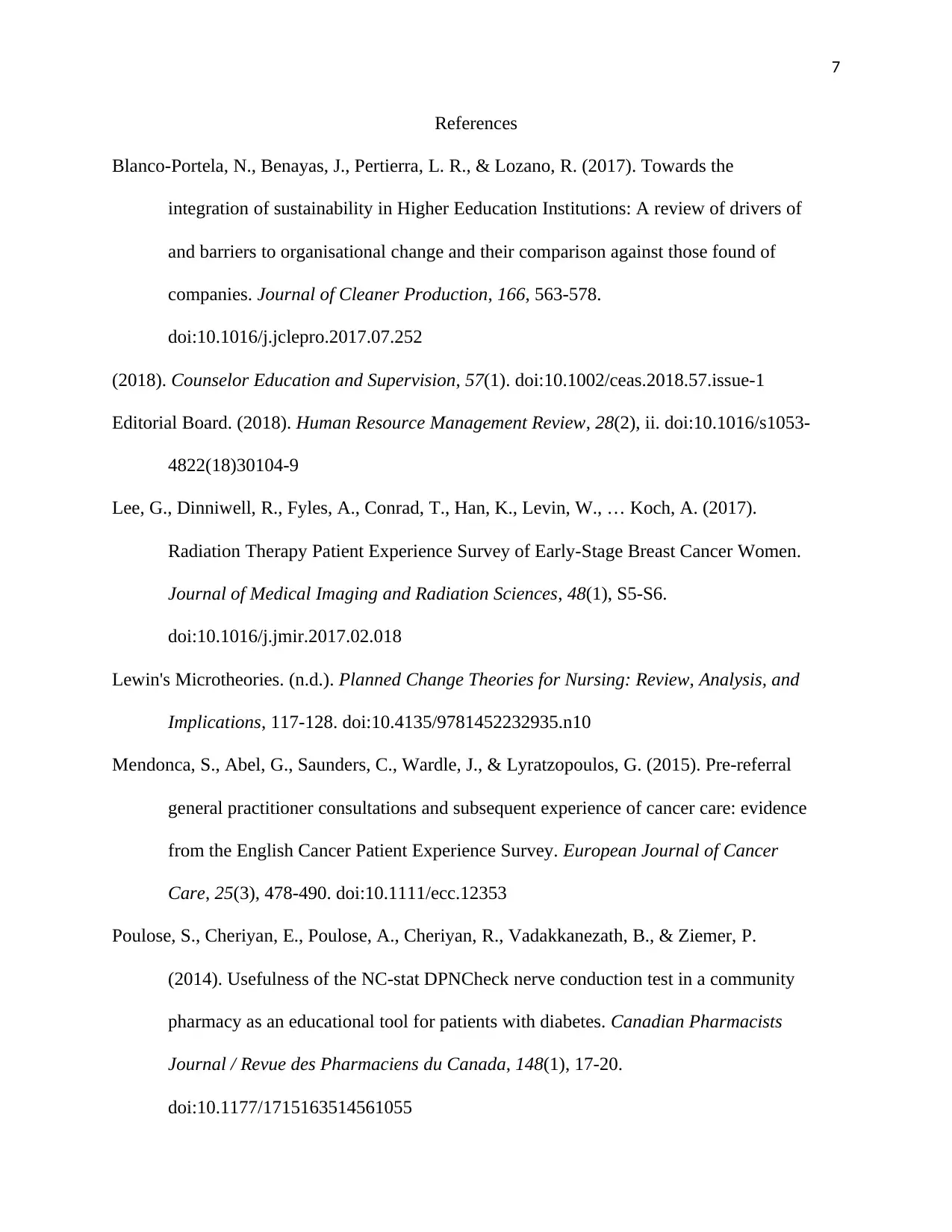
7
References
Blanco-Portela, N., Benayas, J., Pertierra, L. R., & Lozano, R. (2017). Towards the
integration of sustainability in Higher Eeducation Institutions: A review of drivers of
and barriers to organisational change and their comparison against those found of
companies. Journal of Cleaner Production, 166, 563-578.
doi:10.1016/j.jclepro.2017.07.252
(2018). Counselor Education and Supervision, 57(1). doi:10.1002/ceas.2018.57.issue-1
Editorial Board. (2018). Human Resource Management Review, 28(2), ii. doi:10.1016/s1053-
4822(18)30104-9
Lee, G., Dinniwell, R., Fyles, A., Conrad, T., Han, K., Levin, W., … Koch, A. (2017).
Radiation Therapy Patient Experience Survey of Early-Stage Breast Cancer Women.
Journal of Medical Imaging and Radiation Sciences, 48(1), S5-S6.
doi:10.1016/j.jmir.2017.02.018
Lewin's Microtheories. (n.d.). Planned Change Theories for Nursing: Review, Analysis, and
Implications, 117-128. doi:10.4135/9781452232935.n10
Mendonca, S., Abel, G., Saunders, C., Wardle, J., & Lyratzopoulos, G. (2015). Pre-referral
general practitioner consultations and subsequent experience of cancer care: evidence
from the English Cancer Patient Experience Survey. European Journal of Cancer
Care, 25(3), 478-490. doi:10.1111/ecc.12353
Poulose, S., Cheriyan, E., Poulose, A., Cheriyan, R., Vadakkanezath, B., & Ziemer, P.
(2014). Usefulness of the NC-stat DPNCheck nerve conduction test in a community
pharmacy as an educational tool for patients with diabetes. Canadian Pharmacists
Journal / Revue des Pharmaciens du Canada, 148(1), 17-20.
doi:10.1177/1715163514561055
References
Blanco-Portela, N., Benayas, J., Pertierra, L. R., & Lozano, R. (2017). Towards the
integration of sustainability in Higher Eeducation Institutions: A review of drivers of
and barriers to organisational change and their comparison against those found of
companies. Journal of Cleaner Production, 166, 563-578.
doi:10.1016/j.jclepro.2017.07.252
(2018). Counselor Education and Supervision, 57(1). doi:10.1002/ceas.2018.57.issue-1
Editorial Board. (2018). Human Resource Management Review, 28(2), ii. doi:10.1016/s1053-
4822(18)30104-9
Lee, G., Dinniwell, R., Fyles, A., Conrad, T., Han, K., Levin, W., … Koch, A. (2017).
Radiation Therapy Patient Experience Survey of Early-Stage Breast Cancer Women.
Journal of Medical Imaging and Radiation Sciences, 48(1), S5-S6.
doi:10.1016/j.jmir.2017.02.018
Lewin's Microtheories. (n.d.). Planned Change Theories for Nursing: Review, Analysis, and
Implications, 117-128. doi:10.4135/9781452232935.n10
Mendonca, S., Abel, G., Saunders, C., Wardle, J., & Lyratzopoulos, G. (2015). Pre-referral
general practitioner consultations and subsequent experience of cancer care: evidence
from the English Cancer Patient Experience Survey. European Journal of Cancer
Care, 25(3), 478-490. doi:10.1111/ecc.12353
Poulose, S., Cheriyan, E., Poulose, A., Cheriyan, R., Vadakkanezath, B., & Ziemer, P.
(2014). Usefulness of the NC-stat DPNCheck nerve conduction test in a community
pharmacy as an educational tool for patients with diabetes. Canadian Pharmacists
Journal / Revue des Pharmaciens du Canada, 148(1), 17-20.
doi:10.1177/1715163514561055
Paraphrase This Document
Need a fresh take? Get an instant paraphrase of this document with our AI Paraphraser
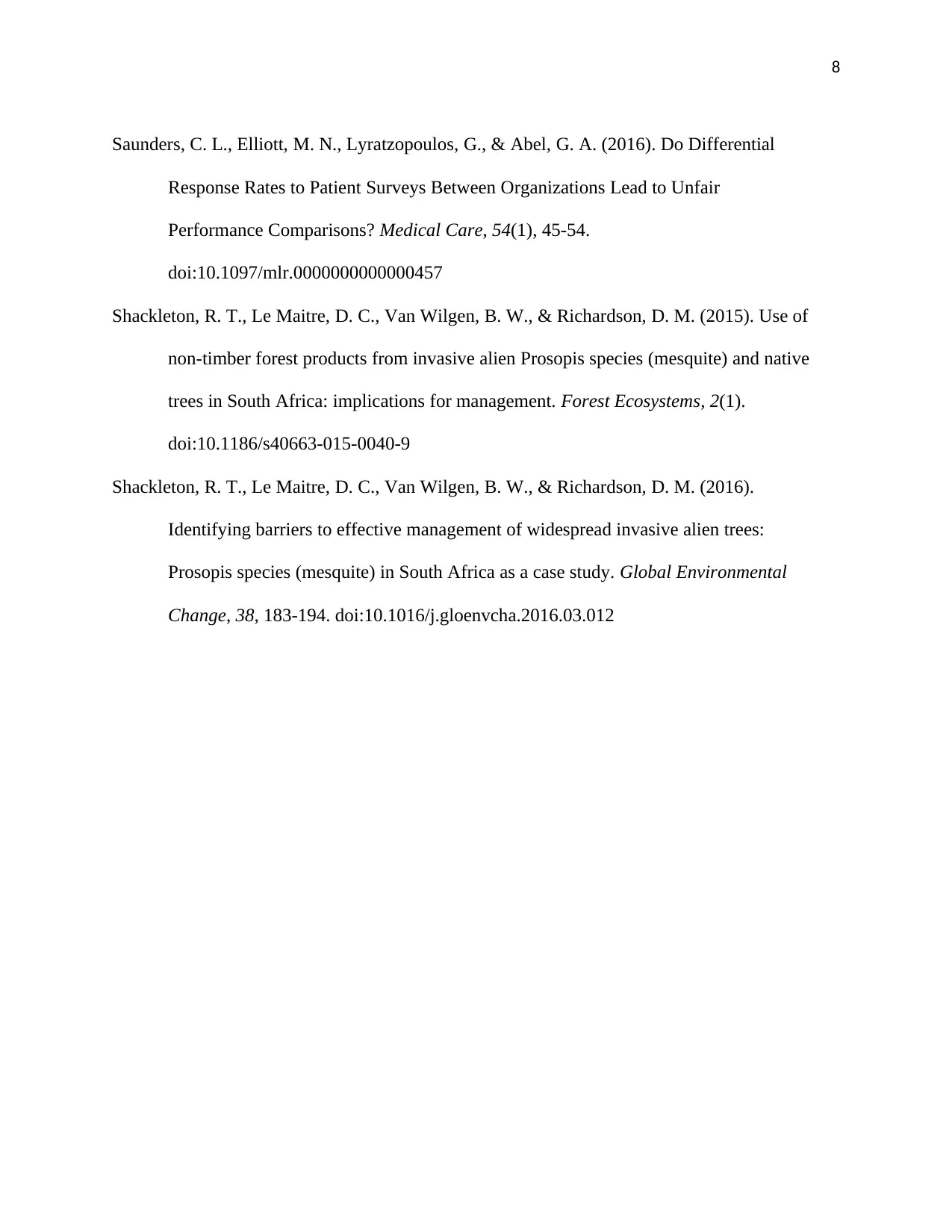
8
Saunders, C. L., Elliott, M. N., Lyratzopoulos, G., & Abel, G. A. (2016). Do Differential
Response Rates to Patient Surveys Between Organizations Lead to Unfair
Performance Comparisons? Medical Care, 54(1), 45-54.
doi:10.1097/mlr.0000000000000457
Shackleton, R. T., Le Maitre, D. C., Van Wilgen, B. W., & Richardson, D. M. (2015). Use of
non-timber forest products from invasive alien Prosopis species (mesquite) and native
trees in South Africa: implications for management. Forest Ecosystems, 2(1).
doi:10.1186/s40663-015-0040-9
Shackleton, R. T., Le Maitre, D. C., Van Wilgen, B. W., & Richardson, D. M. (2016).
Identifying barriers to effective management of widespread invasive alien trees:
Prosopis species (mesquite) in South Africa as a case study. Global Environmental
Change, 38, 183-194. doi:10.1016/j.gloenvcha.2016.03.012
Saunders, C. L., Elliott, M. N., Lyratzopoulos, G., & Abel, G. A. (2016). Do Differential
Response Rates to Patient Surveys Between Organizations Lead to Unfair
Performance Comparisons? Medical Care, 54(1), 45-54.
doi:10.1097/mlr.0000000000000457
Shackleton, R. T., Le Maitre, D. C., Van Wilgen, B. W., & Richardson, D. M. (2015). Use of
non-timber forest products from invasive alien Prosopis species (mesquite) and native
trees in South Africa: implications for management. Forest Ecosystems, 2(1).
doi:10.1186/s40663-015-0040-9
Shackleton, R. T., Le Maitre, D. C., Van Wilgen, B. W., & Richardson, D. M. (2016).
Identifying barriers to effective management of widespread invasive alien trees:
Prosopis species (mesquite) in South Africa as a case study. Global Environmental
Change, 38, 183-194. doi:10.1016/j.gloenvcha.2016.03.012
1 out of 8
Related Documents
Your All-in-One AI-Powered Toolkit for Academic Success.
+13062052269
info@desklib.com
Available 24*7 on WhatsApp / Email
![[object Object]](/_next/static/media/star-bottom.7253800d.svg)
Unlock your academic potential
Copyright © 2020–2025 A2Z Services. All Rights Reserved. Developed and managed by ZUCOL.




